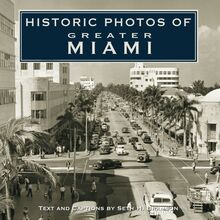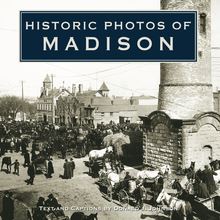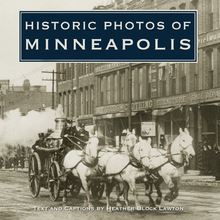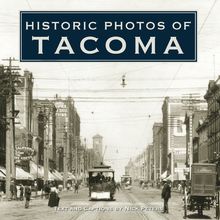Historic Photos of Jacksonville , livre ebook
174
pages
English
Ebooks
2006
Vous pourrez modifier la taille du texte de cet ouvrage
Obtenez un accès à la bibliothèque pour le consulter en ligne En savoir plus
Découvre YouScribe en t'inscrivant gratuitement
Découvre YouScribe en t'inscrivant gratuitement
174
pages
English
Ebooks
2006
Vous pourrez modifier la taille du texte de cet ouvrage
Obtenez un accès à la bibliothèque pour le consulter en ligne En savoir plus
Publié par
Date de parution
01 décembre 2006
Nombre de lectures
2
EAN13
9781618586438
Langue
English
Poids de l'ouvrage
9 Mo
By the late nineteenth century, the city of Jacksonville was a vibrant cultural center on Florida’s Atlantic coast. Through changing fortunes, Jacksonville has continued to grow and prosper by overcoming adversity and maintaining the strong, independent culture of its citizens.
Historic Photos of Jacksonville captures this journey through still photography selected from the finest archives. From the Gilded Age to the extension of the Florida East Coast Railroad, the Great Fire of 1901 to the installation of three major naval bases, Historic Photos of Jacksonville follows life, government, education, and events throughout the city’s history.
This volume captures unique and rare scenes as depicted in nearly 200 historic photographs. Published in striking black and white, these images communicate historic events and everyday life of two centuries of people building a unique and prosperous city.
Publié par
Date de parution
01 décembre 2006
Nombre de lectures
2
EAN13
9781618586438
Langue
English
Poids de l'ouvrage
9 Mo
HISTORIC PHOTOS OF
JACKSONVILLE
T EXT AND C APTIONS BY C AROLYN W ILLIAMS
A view of the wharf along Bay Street in the early 1900s
Turner Publishing Company
200 4th Avenue North Suite 950
Nashville, Tennessee 37219
(615) 255-2665
www.turnerpublishing.com
Historic Photos of Jacksonville
Copyright 2007 Turner Publishing Company
All rights reserved.
This book or any part thereof may not be reproduced or transmitted in any form or by any means, electronic or mechanical, including photocopying, recording, or by any information storage and retrieval system, without permission in writing from the publisher.
Library of Congress Control Number: 2006935406
ISBN-13: 978-1-59652-311-1
ISBN: 1-59652-311-5
Printed in the United States of America
09 10 11 12 13 14-0 9 8 7 6 5 4
C ONTENTS
A CKNOWLEDGMENTS
P REFACE
F ROM A L ONG AND S LOW B EGINNING TO THE G REAT F IRE OF 1901 (1850-1901)
F ROM A SHES TO AN I MPORTANT N EW S OUTH C ITY (1902-1919)
F ROM THE R OARING T WENTIES TO THE E RA OF THE G REAT D EPRESSION (1920-1939)
F ROM W ORLD W AR II TO THE S IXTIES (1940-1960 S )
N OTES ON THE P HOTOGRAPHS
From May 29 to October 24, 1898, the 4th Illinois regiment was stationed here at Camp Cuba Libre, in East Springfield on Ionia Street.
A CKNOWLEDGMENTS
This volume, Historic Photos of Jacksonville , is the result of the cooperation and efforts of many individuals and organizations. It is with great thanks that we acknowledge in particular the generous assistance of the State Archives of Florida
We would also like to thank the following individuals for their valuable contributions and assistance in making this work possible:
N. Adam Watson, Photographic Archivist, State Archives of Florida
Carolyn Williams, our writer, Associate Professor of History, University of North Florida in Jacksonville
P REFACE
Jacksonville has thousands of historic photographs that reside in archives, both locally and nationally. This book began with the observation that, while those photographs are of great interest to many, they are not easily accessible. During a time when Jacksonville is looking ahead and evaluating its future course, many people are asking, How do we treat the past? These decisions affect every aspect of the city-architecture, public spaces, commerce, infrastructure-and these, in turn, affect the way that people live their lives. This book seeks to provide easy access to a valuable, objective look into the history of Jacksonville.
The power of photographs is that they are less subjective than words in their treatment of history. Although the photographer can make decisions regarding subject matter and how to capture and present it, photographs do not provide the breadth of interpretation that text does. For this reason, they offer an original, untainted perspective that allows the viewer to interpret and observe.
This project represents countless hours of review and research. The researchers and writer have reviewed thousands of photographs in numerous archives. We greatly appreciate the generous assistance of those listed in the acknowledgments of this work, without whom this project could not have been completed.
The goal in publishing this work is to provide broader access to this set of extraordinary photographs which seek to inspire, provide perspective, and evoke insight that might assist people who are responsible for determining Jacksonville s future. In addition, the book seeks to preserve the past with adequate respect and reverence.
With the exception of touching up imperfections that have accrued with the passage of time and cropping where necessary, no other changes have been made. The focus and clarity of many images is limited to the technology and the ability of the photographer at the time they were taken.
The work is divided into eras. Beginning with some of the earliest known photographs of Jacksonville, the first section records photographs from before the Civil War through the end of the nineteenth century. The second section spans the beginning of the twentieth century to the beginning of the 1920s. Section Three moves from the Roaring Twenties to the eve of World War II. The last section covers the war era to the 1960s.
In each of these sections we have made an effort to capture various aspects of life through our selection of photographs. People, commerce, transportation, infrastructure, religious institutions, and educational institutions have been included to provide a broad perspective.
We encourage readers to reflect as they go walking in Jacksonville, strolling through the city, its parks, and its neighborhoods. It is the publisher s hope that in utilizing this work, longtime residents will learn something new and that new residents will gain a perspective on where Jacksonville has been, so that each can contribute to its future.
-Todd Bottorff, Publisher
Schooners like the Lillie of Key West shown here transported cargo to and from the docks of Jacksonville. Since there were no railroads south of the city, these vessels played an important role in economic development. The St. Johns River was the main artery of trade, providing the only channel of transport for freight and people.
F ROM A L ONG AND S LOW B EGINNING TO THE G REAT F IRE OF 1901
(1850-1901)
Jacksonville begins with the river that is known today as the St. Johns. The various names by which the river and city have been known reflect the many and varied human settlers who have occupied and shaped them. The Timucuans, the indigenous people that Europeans encountered upon arrival, called the region Wileka, meaning land of lakes because of the many springs and marshes collected by the river over thousands of years. The French dubbed the river River de May to mark the date of their arrival on May 1, 1562, and named the settlement they established Fort Caroline in honor of their king, Charles IX.
The presence of the French Huguenots in the land they had claimed and named La Florida motivated the Spanish Catholics to form their own settlement, St. Augustine, in 1565. From their fort the Spanish launched an attack that resulted in the removal of the French and yet another name for the fort and the river, San Mateo, for St. Matthew, whose feast day was celebrated the day of the conquest.
The Spanish managed to hold on to the region for more than two centuries (with the brief interruption of a British occupation from 1763 to 1783, when the river received the name it bears today, the St. Johns River). The Seminoles, who had replaced the long-vanished Timucuans, called the settlement Wacca Pilatka or Cowford (as the English translated it) until the early 1800s.
After the second and final war between Britain and the United States (the War of 1812), the most famous hero from that war, Andrew Jackson, headed an expedition that culminated in the transfer by Spain of Florida to the United States in 1821. The following year Jacksonville was named by Isaiah Hart, its main founder, for Old Hickory, who served as the first governor of Florida under U.S. control, from March 10 to December 31, 1821.
During the territorial stage of Florida (1821-1845) until the Civil War era, Jacksonville, like the state as a whole, grew slowly. The area was home to plantations, introduced during the British period, where Sea Island cotton, indigo, and sugar were grown, and which became a permanent part of the economic and social landscape. The timber industry was another mainstay of the economy. Throughout this period Jacksonville evolved from a trading post to a city as the residents grappled with wars, fires, and other disasters.
Because of the river (just 25 miles away and providing the most direct access to the Atlantic Ocean), Jacksonville became a center of Civil War activity. Although no major battles took place, the town was invaded four times by the Union army. The Union forces served as a magnet to slaves, who believed that freedom was as close as the river, and who fled the farms and plantations in northeast Florida and Georgia. Many former soldiers, black and white, stayed in the area after the war, when Jacksonville experienced its first major stage of city building until the early twentieth century and a yellow fever epidemic in 1888. By the end of the century, in addition to serving as the state s main port, Jacksonville was the center of state tourism. All this growth came to an abrupt end on May 3, 1901, when the city succumbed to a massive fire.
This building is probably St. Paul s Methodist Church, constructed in 1858 and serving the congregation until 1890, when it was sold to Catholics. The structure was later moved across the street to the corner of Newnan and Duval and used as a hall. It was destroyed by the fire of 1901.
This depot belonged to the Florida Atlantic Gulf Coast Railroad, which ran from Jacksonville to Lake City. The structure was mainly a platform without a shed. Only one train arrived and departed every 24 hours.
By the time of the war, Jacksonville (incorporated as a city in 1859) was bounded by Hogan s Creek on the north and west Pine Street (today s Main Street) and the St. Johns River on the south. Although much of the fledgling commercial district was destroyed during the four invasions of federal troops, some stores survived the end of the war. This bakery, probably Rivas and Koghman, was located on the north side of Bay Street, between Ocean and Newnan streets.
The store at left, at the corner of Bay and Hogan streets, was owned by local entrepreneur Calvin Lewis Robinson. The building burned in 1865.
Union troops built signal towers like the one pictured here to communicate with each other and with ships offshore. This tower was located in what was then called the public square (today Hemming Park). The top of the tower was enclosed to protect the signalmen from Confederate snipers.
After the Battle of Olustee, the most significant Confederate victory in Flo














